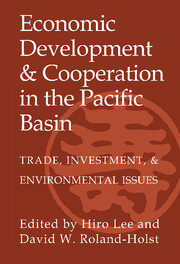 Economic Development and Cooperation in the Pacific Basin
Economic Development and Cooperation in the Pacific Basin Book contents
- Frontmatter
- Contents
- Acknowledgments
- List of Contributors
- I Introduction and Overview
- II U.S.-Japan and Asian Trade Patterns
- III Regional Trading Arrangements in the Pacific Basin
- IV Foreign Direct Investment: Determinants and Consequences
- 7 The Determinants of Foreign Direct Investment: A Survey with Applications to the United States
- 8 Are Trade and Direct Investment Substitutes or Complements? An Empirical Analysis of Japanese Manufacturing Industries
- 9 Korea's Outward Foreign Direct Investment and the Division of Labor in the Asia-Pacific
- 10 China's Absorption of Foreign Direct Investment
- 11 The Impact of Foreign Investment in Indonesia: Historical Trends and Simulation Analysis
- V Trade, Resources, and the Environment
- Index
7 - The Determinants of Foreign Direct Investment: A Survey with Applications to the United States
Published online by Cambridge University Press: 19 May 2010
- Frontmatter
- Contents
- Acknowledgments
- List of Contributors
- I Introduction and Overview
- II U.S.-Japan and Asian Trade Patterns
- III Regional Trading Arrangements in the Pacific Basin
- IV Foreign Direct Investment: Determinants and Consequences
- 7 The Determinants of Foreign Direct Investment: A Survey with Applications to the United States
- 8 Are Trade and Direct Investment Substitutes or Complements? An Empirical Analysis of Japanese Manufacturing Industries
- 9 Korea's Outward Foreign Direct Investment and the Division of Labor in the Asia-Pacific
- 10 China's Absorption of Foreign Direct Investment
- 11 The Impact of Foreign Investment in Indonesia: Historical Trends and Simulation Analysis
- V Trade, Resources, and the Environment
- Index
Summary
INTRODUCTION
As several contributions in this volume affirm, foreign direct investment (FDI) is emerging as an essential element in the economic strategies of virtually all East Asian countries. This is a relatively new development. The earlier policy regimes of Japan and Korea actively discouraged FDI. Many other countries heavily regulated FDI flows, and often banned investments in key sectors. These restrictions were typically aimed at U.S. FDI, which accounted for nearly two-thirds of developed-country FDI outflows in the 1960s and about one-half in the 1970s (Lipsey, 1993). But the positive experiences of countries that welcomed FDI, including especially Singapore and Malaysia, have shown that FDI can augment national savings and foreign exchange without creating debt, and can also provide access to technology and management know-how. Today FDI is typically seen as a facilitator of development and technological catch-up, and even as a source of “leapfrogging technologies” that allow developing countries to bypass intermediate stages of development in some industries.
In line with these changing perspectives, many of the developing countries of the Asia-Pacific region have recently liberalized restrictions on FDI and introduced promotional incentives. These policy measures have interacted with the region's attractive growth prospects, efficient production environment, and stable macroeconomic performance to produce impressive results. The region's FDI inflows have sharply expanded and now flow not only from traditional developed partners such as the United States and Japan but also from the region's own newly industrialized economies (NIEs) (Ramstetter and Plummer, 1991).
- Type
- Chapter
- Information
- Economic Development and Cooperation in the Pacific BasinTrade, Investment, and Environmental Issues, pp. 233 - 250Publisher: Cambridge University PressPrint publication year: 1998
- 1
- Cited by


